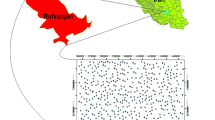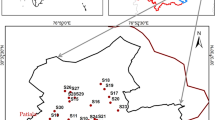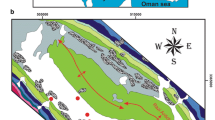Abstract
Basaltic aquifers represent one of the major groundwater resources in the Arabian Shield, which lies in the western part of the Kingdom of Saudi Arabia. This study aimed to evaluate the quality of groundwater drawn from the Tertiary and Quaternary basaltic aquifer system of the northern part of Harrat Rahat in Al-Madinah Al-Munawwarah area for the purposes of household use and irrigation. Forty-five groundwater samples were collected and analyzed for physical and chemical parameters: pH, HCO3–, Na+, K+, Mg2+, Ca2+, SO42–, Cl–, CO32–, electrical conductivity, total dissolved solids, and total hardness. Groundwater drinkability was assessed based on a water quality index (WQI) and the results were compared to international and local water quality standards. Sodium adsorption ratio (SAR), residual sodium carbonate (RSC), corrosivity ratio (CR), and boron toxicity (BT) were used to assess the suitability of the sampled groundwater for agricultural uses. The major cations abundance in groundwater are in the order Na+ > Ca2+ > Mg2+ > K+, while the major anions are Cl– > SO42–. A Piper diagram indicates that there are three water types in the study area: sodium chloride (NaCl), calcium chloride (CaCl), and mixed water. Based on the WQI analysis, the groundwater was classified into different categories that link its suitability for drinking purposes. Generally, 93% of the groundwater shows very poor to unsuitable quality for household uses. SAR, CR, RSC, and BT analyses indicate that the existing groundwater is considered permissible for cultivation activities.
Résumé
Les aquifères basaltiques représentent des ressources importantes en eau souterraine dans le socle Arabique situé dans la partie ouest de l’Arabie saoudite. Cette étude a pour objectif d’évaluer la qualité des eaux souterraines extraites du système aquifère basaltique tertiaire et quaternaire de la partie nord du Harrat Rahat, dans le secteur de la ville de Médine (Al-Madinah Al-Munawwarah), pour des usages domestique et d’irrigation. Quarante-cinq échantillons d’eau souterraine ont été collectés et analysés pour les paramètres physiques et chimiques : pH, HCO3–, Na+, K+, Mg2+, Ca2+, SO42–, Cl–, CO32–, conductivité électrique, matières dissoutes totales (TDS) et dureté totale. La potabilité de l’eau souterraine a été évaluée sur la base de l’indice de qualité des eaux (water quality index – WQI) et les résultats comparés avec les normes internationale et locale de qualité de l’eau. Le rapport d’absorption du sodium (SAR), le carbonate de sodium résiduel (RSC), le rapport de corrosivité (CR) et la toxicité du bore (BT) ont été utilisés pour évaluer l’applicabilité des eaux échantillonnées pour les usages agricoles. L’abondance des cations majeurs dans l’eau souterraine est par ordre décroissant Na+ > Ca2+ > Mg2+ > K+, et Cl– > SO42– pour les anions majeurs. Un diagramme de Piper indique la présence de trois types d’eau dans le secteur étudié: des eaux chlorurée-sodique (NaCl), des eaux chlorurée-calcique (CaCl) et des eaux de mélange. Sur la base de l’analyse du WQI, l’eau souterraine est classée en différentes catégories selon les possibilités d’utilisation comme eau potable. Dans l’ensemble, 93% de l’eau souterraine présente une qualité très médiocre voire non adaptée à un usage domestique. Les paramètres SAR, CR, RSC et BT indiquent que l’eau souterraine est considérée comme acceptable pour des usages agricoles.
Resumen
Los acuíferos basálticos representan uno de los principales recursos hídricos subterráneos del escudo árabe, que se encuentra en la parte occidental del Reino de Arabia Saudí. El objetivo de este estudio era evaluar la calidad de las aguas subterráneas que se extraen del sistema acuífero basáltico terciario y cuaternario de la parte norte de Harrat Rahat, en la zona de Al-Madinah Al-Munawwarah, para su uso doméstico y de riego. Se recogieron 45 muestras de agua subterránea y se analizaron los parámetros físicos y químicos: pH, HCO3–, Na+, K+, Mg2+, Ca2+, SO42–, Cl–, CO32–, conductividad eléctrica, sólidos disueltos totales y dureza total. La aptitud para el consumo de las aguas subterráneas se evaluó sobre la base de un índice de calidad del agua (WQI) y los resultados se compararon con las normas de calidad del agua internacionales y locales. Se utilizaron el índice de adsorción de sodio (SAR), el carbonato de sodio residual (RSC), el índice de corrosividad (CR) y la toxicidad del boro (BT) para evaluar la aptitud de las aguas subterráneas muestreadas para usos agrícolas. La abundancia de los principales cationes en el agua subterránea sigue el orden Na+ > Ca2+ > Mg2+ > K+, mientras que los principales aniones son Cl– > SO42–. Un diagrama de Piper indica que hay tres tipos de agua en la zona de estudio: la clorurada sódica (NaCl), la clorurada cálcica (CaCl) y la mixta. Basándose en el análisis WQI, las aguas subterráneas se clasificaron en diferentes categorías que vinculan su aptitud para el consumo. En general, el 93% de las aguas subterráneas muestra una calidad entre muy pobre y no apta para usos domésticos. Los análisis SAR, CR, RSC y BT indican que las aguas subterráneas existentes se consideran aptas para las actividades de cultivo.
摘要
玄武岩含水层位于沙特阿拉伯王国西部Arabian Shield的主要地下水资源之一。本研究旨在评估取自 Al-Madinah Al-Munawwarah 地区 Harrat Rahat 北部第三纪和第四纪玄武岩含水层系统的地下水质量,用于家庭用水和灌溉。收集并分析了 45 个地下水样品的物理和化学参数:pH, HCO3-, Na+, K+, Mg2+, Ca2+, SO42-, Cl-, CO32-、电导率、总溶解固体和总硬度。根据水质指数(WQI)评估地下水可饮用性,并将结果与国际和当地水质标准进行比较。钠吸附比 (SAR)、残留碳酸钠(RSC)、腐蚀性比(CR)和硼毒性(BT)用于评估采样地下水对农业用途的适用性。地下水中主要阳离子丰度依次为Na+ > Ca2+ > Mg2+ > K+,而主要阴离子为Cl- > SO42-。 Piper 图表明研究区存在三种水类型:氯化钠(NaCl)、氯化钙(CaCl)和混合水。根据 WQI 分析,地下水被分为不同的类别,将其与饮用目的建立适宜性。一般来说,93% 的地下水质量非常差,不适合家庭使用。 SAR、CR、RSC 和 BT 分析表明,现有地下水被认为可用于耕作活动。
Resumo
Os aquíferos basálticos representam um dos principais recursos hídricos subterrâneos do Escudo Árabe, que fica na parte ocidental do Reino da Arábia Saudita. Este estudo teve como objetivo avaliar a qualidade das águas subterrâneas extraídas do sistema aquífero basáltico Terciário e Quaternário da parte norte de Harrat Rahat na área de Al-Madinah Al-Munawwarah, para fins de uso doméstico e irrigação. Quarenta e cinco amostras de águas subterrâneas foram coletadas e analisadas quanto aos parâmetros físicos e químicos: pH, HCO3–, Na+, K+, Mg2+, Ca2+, SO42–, Cl–, CO32–, condutividade elétrica, sólidos totais dissolvidos e dureza total. A potabilidade da água subterrânea foi avaliada com base em um índice de qualidade da água (IQA) e os resultados foram comparados com os padrões internacionais e locais de qualidade da água. A razão de adsorção de sódio (RAS), carbonato de sódio residual (CSR), razão de corrosividade (RC) e toxicidade de boro (TB) foram usados para avaliar a adequação das águas subterrâneas amostradas para usos agrícolas. A abundância dos principais cátions nas águas subterrâneas está na ordem Na+ > Ca2+ > Mg2+ > K+, enquanto os principais ânions são Cl– > SO42–. Um diagrama de Piper indica que existem três tipos de água na área de estudo: cloreto de sódio (NaCl), cloreto de cálcio (CaCl) e água mista. Com base na análise do IQA, as águas subterrâneas foram classificadas em diferentes categorias que relacionam a sua aptidão para consumo. Geralmente, 93% das águas subterrâneas apresentam qualidade muito ruim a inadequada para uso doméstico. As análises RAS, RC, CSR e TB indicam que as águas subterrâneas existentes são consideradas permissíveis para atividades de cultivo.














Similar content being viewed by others
References
Abu Jaber N (2001) Geochemical evolution and recharge of the shallow aquifers at Tulul al Ashaqif, NE Jordan. Environ Geol 41:337–383
Adams S, Titus R, Pietersen K, Tredoux G, Harris C (2001) Hydrochemical characteristics of aquifer near Sutherland in the Western Karoo, South Africa. J Hydrol 241:91–103
Al-Shaibani AA, AboKhodair L, Al-Amari (2007) Hydrogeological and quantitative groundwater assessment of The Basaltic Aquifer, northern Harrat Rahat, Saudi Arabia. Arab Gulf J Sci Res 25(1–2):39-49
Appelo CA, Postma D (1993) Geochemistry, groundwater and pollution. Balkema, Rotterdam, The Netherlands
Bayumi TH (1992) Groundwater resources of the northern part of Harrat Rahat Plateau, Saudi Arabia. PhD Thesis, King Abdulaziz University, Jeddah, Saudi Arabia
Back W, Hanshaw BB (1965) Chemical geohydrology. Adv Hydro Sci 1:49–109
Camp R (1969) Groundwater test holes in the Jabal Sayid area. Bur Res Geol Min Open-File Rep 9-99:42, Saudi Arabian Deputy Ministry of Mineral Resources, Riyadh, Saudi Arabia
Camp VE, Roobol MJ (1987) Geologic map of the Cenozoic lava field of Harrat Rahat, Kingdom of Saudi Arabia. Saudi Arabian Deputy Ministry of Mineral Resources Geoscience map (with text), scale 1:250,000. Open-File Rep DGMR-OF-07-9, Saudi Arabian Deputy Ministry of Mineral Resources, Riyadh, Saudi Arabia, 91 pp
Camp VE, Roobol MJ (1989) The Arabian continental alkali basalt province. 1. Evolution of Harrat Rahat, Rahat, Kingdom of Saudi Arabia. Geol Soc Am Bull 101(1):71–95
Cottez S, Hizdeleh Y (1983) Jabal Sayid water supply inventory of agricultural wells in Adh-Dhumariyah and Al-Hijriyah areas. Open-File Report BRGM-OF-03-33, Saudi Arabian Deputy Ministry of Mineral Resources, Riyadh, Saudi Arabia, 31 pp
Daessle M, Durozoy G (1972) Jabal Sayid water supply, the Harrat Rahat basalts. BRGM technical record 72 JED 2, BRGM, Orleans, France
Downs DT, Robinson JE, Stelten ME, Champion DE, Dietterich HR, Sisson TW, Zahran H, Hassan K, Shawali J (2019) Geologic map of the northern Harrat Rahat volcanic field, Kingdom of Saudi Arabia: U.S. geological survey scientific investigations map 3428 [also released as Saudi Geological Survey Special Report SGS–SP–2019–2], 65 p. https://doi.org/10.3133/sim3428
Durozoy G (1970) Groundwater geology of the basalt on the Harrat Rahat plateau. Bur Res Geol Min Open-File Rep 70-JED-24, Ministry of Petroleum and Mineral Resources, Deputy Ministry for Mineral Resources Jiddah, Saudi Arabia, 31 pp
Durozoy G (1968) Water for future mining operations in the Jabal Sayid area, a preliminary groundwater survey. Bur Res Geol Min Open-File Rep 68-JED-44, Ministry of Petroleum and Mineral Resources, Deputy Ministry for Mineral Resources Jiddah, Saudi Arabia, 44 pp
Eaton FM (1950) Significance of carbonates in irrigation waters. Soil Sci 69:123–133
Edmunds WM, Carrillo-Rivera JJ, Cardona A (2002) Geochemical evolution of groundwater beneath Mexico City. J Hydrol 258:1–24
Exner ME, Perea-Estrada H, Spalding RF (2010) Long-term response of groundwater nitrate concentrations to management regulations in Nebraska’s Central Platte Valley. The Sci World J 10:286–297
FAO (2021) AQUASTAT-FAO’s Global Information System on Water and Agriculture, Saudi Arabia. 2021. http://www.fao.org/aquastat/en/. Accessed Sept 2022
Federal Register (2002) National primary drinking water standards, title 40, chap 1, part 14. 69 FR 18803, 62 pp
Fetter CW (2001) Applied hydrogeology, 4th edn. Pearson, Upper Saddle River, NJ
Follett RH, Soltanpour PN (2002) Irrigation water quality criteria. Colorado State University Publication no. 0.506, Colorado State University, Fort Collins, CO
Freeze RA, Cherry JA (1979) Groundwater. Prentice-Hall, NJ, 604 pp
Gastmans D, Chang HK, Hutcheon I (2010) Groundwater geochemical evolution in the northern portion of the Guarani Aquifer System (Brazil) and its relationship to diagenetic features. Appl Geochem 25:16–33
George M, Shorbaji H (1987) Explanatory notes to the hydrogeologic and hydrochemical maps of Al-Madinah quadrangle, sheet 24D, Kingdom of Saudi Arabia. Open-File Report BRGM-OF-07-23, Ministry of Petroleum and Mineral Resources, Deputy Ministry for Mineral Resources Jiddah, Saudi Arabia, 65 pp
GEOCOM (n.d.) Geothermal systems and technologies 7. Geothermal energy for power generation. Geothermal Communities is a project of the CONCERTO Initiative co-funded by the European Commission, pp 1–35. www.scribd.com/document/462518315/7-Geothermal. Accessed Sept 2022
Hounslow AW (1995) Water quality data: analysis and interpretation. CRC, Boca Raton, FL. 416 pp
Horton RK (1965) An index number system for rating water quality. J Water Pollut Control Fed 37(3):300–306
Hussein MT, Adam EG (1995) Water quality in the Gedaref basin, Sudan. Hydrol Sci J 40:205–216
Lloyd JW (1965) The hydrochemistry of the aquifers of north-eastern Jordan. J Hydrol 3:319–330
Locsey KL (2004) Hydrogeochemistry and hydrology of a basalt aquifer. 168. a Ph.D. Thesis, Queensland University of Technology, Brisbane City, Australia
Mansouri RW (2020) Assessment of the hydraulic properties and hydrochemistry of the Basaltic Aquifer, northern part of Harrat Rahat, Saudi Arabia. MSc Thesis, King Fahad University of Petroleum and Minerals, Dhahran, Saudi Arabia
McKenzie JM, Siegel DI, Patterson W, McKenzie DJ (2001) A geochemical survey of the spring water from the main Ethiopian Rift Valley, southern Ethiopia: implications of well-head protection. Groundwater 28:693–702
Miller JA (1999) Ground water atlas of the United States: introduction and national summary. Hydrologic Atlas 730-A, US Geological Survey, Reston, VA
Moll-Stalcup EJ, Arth JG (1991) Isotopic and chemical constraints on the petrogenesis of Blackburn Hills volcanic field, western Alaska. Geochim Cosmochim Acta 55:3753–3776
Möller P, Rosenthal E, Inbar N, Magri F (2016) Hydrochemical considerations for identifying water from basaltic aquifers: the Israeli experience. J Hydrol Reg Stud 5:33–47. https://doi.org/10.1016/j.ejrh.2015.11.016
Moufti MR, Németh K (2016) Harrat Rahat: The Geoheritage Value of the Youngest Long-Lived Volcanic Field in the Kingdom of Saudi Arabia. https://doi.org/10.1007/978-3-319-33015-0_3
Piper AM (1944) A graphic procedure in the geochemical interpretation of water analyses. Eos Trans Am Geophys Union 25:914–928
Richards LA (1954) Diagnosis and improvement of saline and alkaline soils. Handbook, US Department of Agriculture, Washington, DC, 60 pp
Singhal BBS, Gupta RP (1999) Applied hydrogeology of fractured rock. Kluwer, Dordrecht, Germany
Todd DK (1980) Groundwater hydrogeology. Wiley, New York, 535 pp
Torrent H (1979) Jabal Sayid water supply, part I: hydrogeology of Harrat Rahat basalt. Bur Res Geol Min Open-File Rep 76-JED-8:55, Ministry of Petroleum and Mineral Resources, Deputy Ministry for Mineral Resources Jiddah, Saudi Arabia
Tripathi AK, Mishra UK, Mishra A, Tiwari S, Dubey P (2012) Studies of hydrogeochemical in groundwater quality around Chakghat Area, India. Int J Mod Eng Res 2(6):4051–4059
USEPA (2007) Nitrates and nitrites. TEACH chemical summary, toxicity and exposure assessment for children’s health. USEPA, Washington, DC, 15 pp
US Environmental Protection Agency (2012) 2012 Edition of the drinking water standards and health advisories. USEPA, Washington, DC, pp 1–20
US Salinity Laboratory Staff (1954) Diagnosis and improvement of saline and alkali soils: USDA handbook no. 60, USDA, Washington, DC, 160 pp
World Health Organization (WHO) (1980) Nitrate and nitrite in saliva. Oncology 37:227–231. https://doi.org/10.1159/000225441
World Health Organization (WHO) (2012) Water quality for drinking: WHO guidelines. Encycl Earth Sci Ser 876–883. https://doi.org/10.1007/978-1-4020-4410-6_184
Srinivasamoorthy K, Chidambaram S, Prasanna MV, Vasanthavihar M, Peter J, Anandhan P (2008) Identification of major sources controlling groundwater chemistry from hard rock terrain: a case study from Mettur Taluk, Salem district, Tamil Nadu, India. J Earth Syst Sci 117(1):49–58
Zaman M, Shaid S, Heng L (2018) Guideline for salinity assessment, mitigation and adaptation using nuclear and related techniques. https://doi.org/10.1007/978-3-319-96190-3
Acknowledgements
The authors would like to thank the Geosciences Department, College of Petroleum Engineering & Geosciences, KFUPM, for their support and assistance during field and laboratory analysis. A special thank you goes to the Ministry of Environment, Water, and Agriculture for their support, recommendations, and providing facilities during data acquisition. Many thanks go to Prof. Martin Keller, Mr. Peter Forestier, and Mr. Danial Schoenrok for their assistance during the field trips.
Author information
Authors and Affiliations
Corresponding author
Ethics declarations
Conflict of interest
The authors declare that they have no conflict of interest.
Additional information
Publisher’s note
Springer Nature remains neutral with regard to jurisdictional claims in published maps and institutional affiliations.
Rights and permissions
Springer Nature or its licensor (e.g. a society or other partner) holds exclusive rights to this article under a publishing agreement with the author(s) or other rightsholder(s); author self-archiving of the accepted manuscript version of this article is solely governed by the terms of such publishing agreement and applicable law.
About this article
Cite this article
Mansouri, R.W., Al-Shaibani, A.M., Makkawi, M.H. et al. Groundwater quality assessment of northern Harrat Rahat Aquifer, Saudi Arabia. Hydrogeol J 30, 2433–2457 (2022). https://doi.org/10.1007/s10040-022-02540-2
Received:
Accepted:
Published:
Issue Date:
DOI: https://doi.org/10.1007/s10040-022-02540-2




